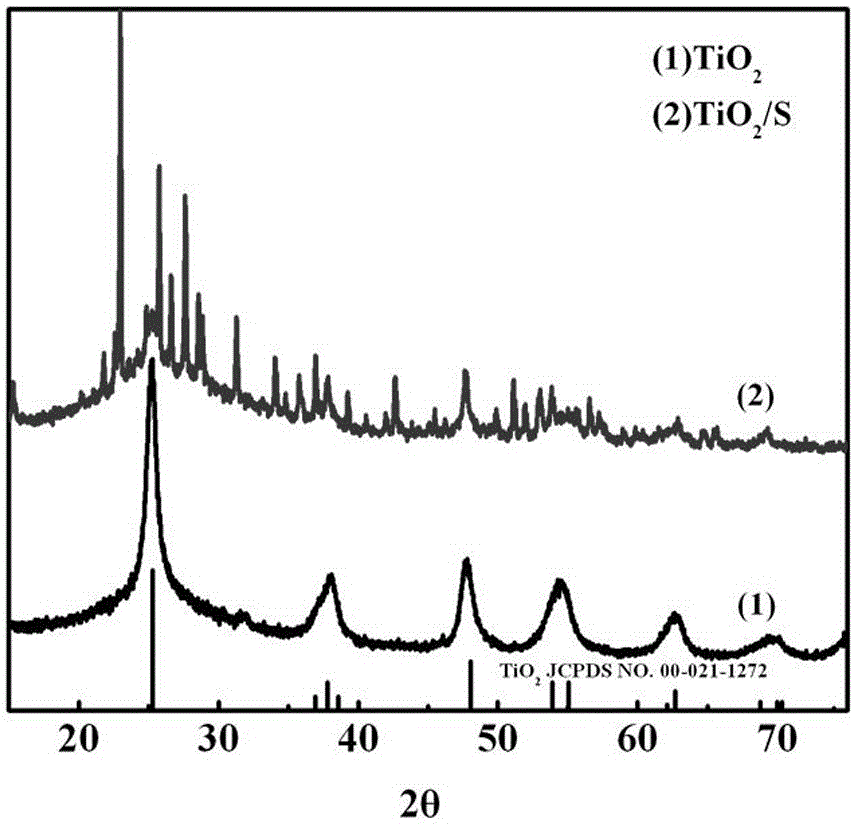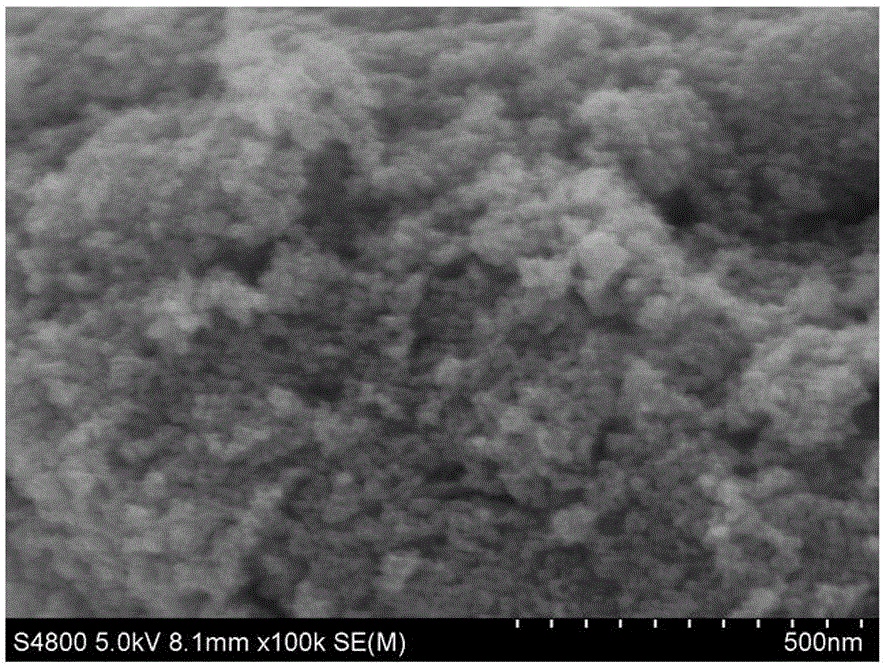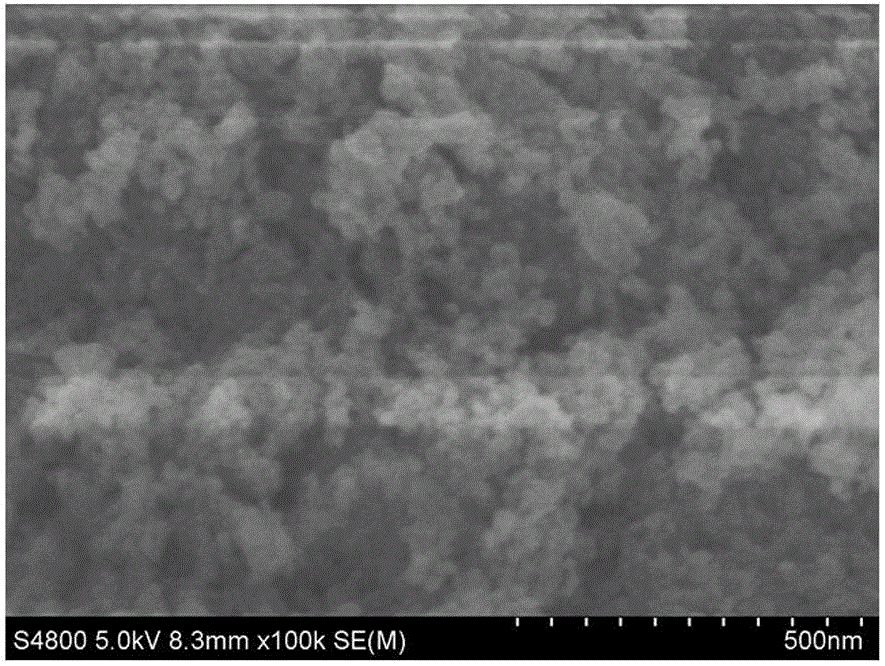Preparation and application of lithium-sulfur battery positive electrode composite material
A technology of lithium-sulfur batteries and composite materials, applied in battery electrodes, lithium batteries, non-aqueous electrolyte batteries, etc., to achieve the effects of good battery cycle performance, good cycle stability, and novel substrate materials
- Summary
- Abstract
- Description
- Claims
- Application Information
AI Technical Summary
Problems solved by technology
Method used
Image
Examples
Embodiment 1
[0021] A method for preparing a lithium-sulfur battery cathode composite material, specifically comprising the steps of:
[0022] (1) 0.5 g anatase TiO 2 The powder was dispersed in 50 mL of 15M KOH solution, stirred for 10 minutes and then transferred to a 75 ml polytetrafluoroethylene-lined autoclave at 180 o C for 72 hours, the resulting precipitate was subjected to 0.1 M H 2 SO 4 The solution was washed several times to pH 1-2, and centrifuged, and then at 70 o Dry in C air for 12 hours to get titanate nanowires;
[0023] (2) Disperse 200 mg of titanate nanowires in 1 M H 2 SO 4 solution, at 70 o C, heated and stirred in a water bath for 7 days, and the white precipitate obtained after natural cooling was washed several times with deionized water, then centrifuged and separated, and then placed in the air for 70 o C dried for 12 hours to obtain anatase phase TiO 2 mesomorph;
[0024] (3) TiO 2 After compound grinding of mesogen and elemental sulfur at a mass ra...
Embodiment 2
[0028] A method for preparing a lithium-sulfur battery cathode composite material, specifically comprising the steps of:
[0029] (1) Add 0.8g anatase TiO 2 The powder was dispersed in 80 mL of 15M KOH solution, stirred for 12 minutes and then transferred to a 90 ml polytetrafluoroethylene-lined autoclave at 150 o C for 80 hours, the resulting precipitate was subjected to 0.1 M H 2 SO 4 The solution was washed several times to pH 1-2, and centrifuged, and then o Dry in C air for 14 hours to obtain titanate nanowires;
[0030] (2) Disperse 200 mg of titanate nanowires in 1 M H 2 SO 4 solution, at 60 o C, heated and stirred in a water bath for 7 days, and the white precipitate obtained after natural cooling was washed several times with deionized water, then centrifuged and separated, and then placed in the air for 60 o C dried for 14 hours to obtain anatase phase TiO 2 mesomorph;
[0031] (3) TiO 2 After compound grinding of mesogen and elemental sulfur at a mass ra...
Embodiment 3
[0034] A method for preparing a lithium-sulfur battery cathode composite material, specifically comprising the steps of:
[0035] (1) Add 1.0g anatase TiO 2 The powder was dispersed in 100mL of 15M KOH solution, stirred for 15 minutes, then transferred to an autoclave with 100 ml of polytetrafluoroethylene lining, at 200 o C for 84 hours, the resulting precipitate was subjected to 0.1 M H 2 SO 4 The solution was washed several times until the pH reached 1-2, and was separated by centrifugation, and then at 80 o Dry in C air for 16 hours to obtain titanate nanowires;
[0036] (2) Disperse titanate nanowires in 1 M H 2 SO 4 solution, at 80 o C, heated and stirred in a water bath for 8 days, and the white precipitate obtained after natural cooling was washed several times with deionized water, then centrifuged and separated, and then placed in the air for 80 o C dried for 16 hours to obtain anatase phase TiO 2 mesomorph;
[0037] (3) TiO 2 After compound grinding of mes...
PUM
 Login to View More
Login to View More Abstract
Description
Claims
Application Information
 Login to View More
Login to View More - R&D
- Intellectual Property
- Life Sciences
- Materials
- Tech Scout
- Unparalleled Data Quality
- Higher Quality Content
- 60% Fewer Hallucinations
Browse by: Latest US Patents, China's latest patents, Technical Efficacy Thesaurus, Application Domain, Technology Topic, Popular Technical Reports.
© 2025 PatSnap. All rights reserved.Legal|Privacy policy|Modern Slavery Act Transparency Statement|Sitemap|About US| Contact US: help@patsnap.com



